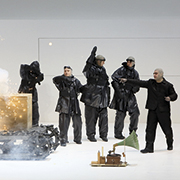The first run of performances has taken place, and what remains are memories of two magnificent hours of contemporary music theatre. Miroslav Srnka’s South Pole was widely acclaimed. A look back.
There is huge surprise when the curtain rises: blazing light with a black cross against the backdrop; acoustically dominant, the morse code, sung staccato, of the Amundsen group on the right – as if a Dada poem has been musically expanded, the Scott group on the left-hand side decodes the signs and establishes that Amundsen has changed direction and is aiming for the Antarctic.
The sprechgesang, or speech-song, of the two “quintets” continues to dominate, for the moment at the same pitch, which intensifies up to a solid fortissimo. The first instrumental intermezzo interrupts with signal-like flashes of sound, sharp and cutting, like sword strokes. After the blazing, bright first image and the short pitch-dark seconds of the interlude, winter follows in dark, contourless blue with cold eruptions of sound to the pain threshold, not primarily because of the volume, but because of the sharpness of the bright and shrill sustained dissonances. The absence of horizon, the white shimmering and the endless expanse are portrayed in a way which is constantly differentiated tonally.
The other events on the stage are just as clearly intelligible, as the story is to some extent a well-known one; the arrangement on the stage does not require close interpretation of changing views, the audience can concentrate fully on the singing and the music. This does not drive the plot forward, it barely intervenes in the course of events, but shapes with different atmospheric intensity the mental states of the protagonists during this race. The short intermezzi, mainly played in the dark, constantly open the ear to this endless, icy expanse with will o’ the wisp and rotating sound clouds (Srnka appropriately calls these “Klangschwärme” [sound swarms]) or scornful croaks on the wind instruments. Sometimes it seems we feel straight in the back of our mind the utter pointlessness of such a race when the sound moves into the dark, brooding lute and collapses into sluggish murmurings. Once at least, when Johansen sees birds and breaks out into a howl of joy, bright, warm sounds wind their way into the heights. I instinctively thought of the “Orel car” passage with the “Svoboda, svobodička” chorus in Janáček’s opera From the house of the dead, that single bright spot in the despair of the prison camp. Almost ninety years lie between these two works, but the reference remained with me to the end of the performance.
Here, with Srnka, it is two women who confront the two main actors in this men’s world, even if only as hallucinations, but who are constantly drawn into alternating singing – and in the sensational quartet which concludes the first part. Srnka always gives priority to the vocal writing; but what somehow burns itself into the memory is the continual re-sounding of long held notes which are pitted against the unechoing expanse.
This is music not only for insiders: the resulting orchestral sound is atmospherically dense, but does not clog up the ears, the eruptions of sound barely ever seem aggressive, the four main roles offer varied, rewarding, indeed sometimes even melodious operatic vocal writing which is able to hold its ground effortlessly against the orchestra.
Jakob Knaus
(from [t]akte 1/2016)
(translation: Elizabeth Robinson)
Press commentaries
“Dieses Werk wird bleiben […] Es höre, sehe und begreife, wer hören, sehen und begreifen kann. Tom Holloways grandioses Libretto zu South Pole aber und Miroslav Srnkas vielleicht noch grandiosere Musik treiben das Konkrete so weit in die Abbreviatur und Abstraktion, lassen umgekehrt alles Abstrakte so konkret werden – und das ist das Neue, auch Radikale an dieser zunächst eher wenig radikal erscheinenden “double opera” –, dass der Mensch sich gleichsam nackt macht. […] Ein gewisses Pathos mag Miroslav Srnka nicht fremd sein. Doch der 40-jährige Tscheche will viel mehr und kann viel mehr. Orchesterklang und Gesang folgen bei ihm einer Schwarm-Ästhetik, und das ist das Aufregende, Neue, wobei einem die Musik nie in den Gehörgängen scheuert: Es sind eben keine abgezirkelten Klangflächen respektive -zustände, die hier quasi impressionistisch entworfen werden, sondern Klangskulpturen, etwas Wesenhaftes, das sich wie aus sich selbst heraus bewegt. Das Movens dazu liegt in den Mikrostrukturen der Partitur, im prismatisch-pointillistischen Zerstäuben vieler Klänge – und auch im Spiel mit einem gewissen Naturalismus: Natürlich hört man Kälte heraus, Knacken, Klirren, Pfeifen, bohrende Ostinati, aufheulende Cluster und dergleichen. Illustrativ aber wird Srnka nie, im Gegenteil, seine Klangfantasie braucht das Gegenständliche nur, um sich daran zu entzünden. […] Ovationen für eine Oper, die ihren Weg gehen wird.”
Christine Lemke-Matwey / DIE ZEIT 4.2.2016
“… eine Parabel auf letzte Dinge, die eiskalt, nicht ohne ironische Brechung, Fragen stellt, die so aktuell sind, dass es klirrt.”
Eleonore Büning / Frankfurter Allgemeine Zeitung 2.2.2016
“Srnka komponiert in keinem Moment illustrativ, sondern sucht mit einer unglaublichen Vielfalt an Klängen eine musikalische Entsprechung für die bedrohliche Stimmung in der Antarktis und schafft äußerst komplexe wie atmosphärische Hörbilder. Ihm gelingt es, dem blendenden Weiß des Sonnenlichtes klangliche Konturen zu geben, aber auch die klirrende Polarkälte kriecht einem beim Hören in die Glieder. Bläser und Streicher werden oft geteilt und sorgen für zarte, fast beiläufige Klänge.”
Yvonne Petitpierre / Deutschlandfunk 2.2.2016
“[Srnka] findet überaus atmosphärische Klänge für die klirrende, Tod bringende Kälte. Auch die Gewalt der arktischen Natur und ihre fade schimmernde Gleichgültigkeit kommt mit faszinierenden Glissandi, beißenden Clustern und Mark erschütterndem Donner aus dem Orchestergraben.”
DeutschlandRadio Kultur 31.1.2016



